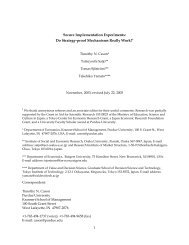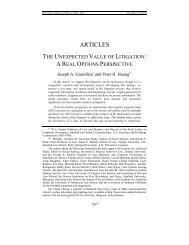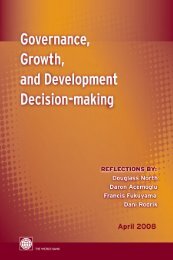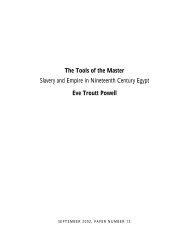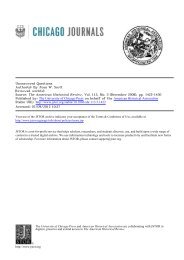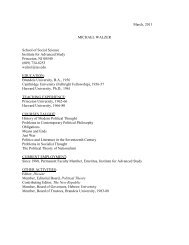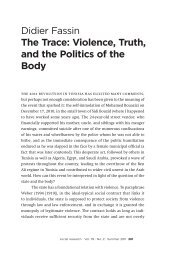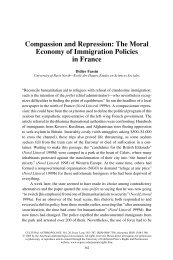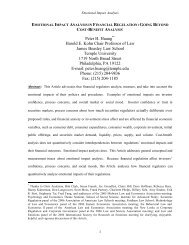Life & Times of Magda A: Telling a Story of Violence in South Africa
Life & Times of Magda A: Telling a Story of Violence in South Africa
Life & Times of Magda A: Telling a Story of Violence in South Africa
Create successful ePaper yourself
Turn your PDF publications into a flip-book with our unique Google optimized e-Paper software.
238 Current Anthropology Volume 49, Number 2, April 2008<br />
de facto authority were not the same. Women’s new role<br />
sought recognition through the life history (the witness<strong>in</strong>g <strong>of</strong><br />
div<strong>in</strong>e grace) produced dur<strong>in</strong>g collective prayer.<br />
As <strong>Magda</strong> A says, produc<strong>in</strong>g and repeat<strong>in</strong>g this narrative<br />
and, eventually, see<strong>in</strong>g it put <strong>in</strong>to writ<strong>in</strong>g and distributed<br />
means master<strong>in</strong>g a realm <strong>of</strong> memory (Nora, Kritzman, and<br />
Goldhammer 1998) <strong>of</strong> the self. The narrative is this realm <strong>in</strong><br />
which memories work, and the “Christian” framework (Halbwachs<br />
1994) allows people to compare themselves with one<br />
another. In a shared framework, each <strong>in</strong>dividual negotiates<br />
social connection and asks for recognition as a collective narrative<br />
takes shape and experiences are shared. In turn, subjects<br />
take strength from this process <strong>in</strong> order to give their lives a<br />
“modern” mean<strong>in</strong>g (Jewsiewicki 2004, 2005).<br />
This narrative construction, which unfolds l<strong>in</strong>early, projects<br />
the subject’s goal and identification <strong>of</strong> action <strong>in</strong>to the future<br />
and thus produces the coherence <strong>of</strong> life. The narrative and<br />
experience <strong>of</strong> Rigoberta Menchú (Burgos-Debray 1984; Stoll<br />
and Arias 2001) are an example <strong>of</strong> this. The success <strong>of</strong> her<br />
narrative is not unrelated to her Nobel Peace Prize and gives<br />
coherence both to her past experience and to the construction<br />
<strong>of</strong> her public personality as the author <strong>of</strong> that life history.<br />
<strong>Magda</strong> A’s desire to broadcast the narrative under her own<br />
name demonstrates an awareness that political social action<br />
calls for representation. The narrative <strong>of</strong> an experience <strong>of</strong> a<br />
traumatic event (the narrative <strong>of</strong> div<strong>in</strong>e grace) is an avenue<br />
for obta<strong>in</strong><strong>in</strong>g the recognition <strong>of</strong> others and turns the future<br />
<strong>in</strong>to the accomplishment <strong>of</strong> the mission thus received. As a<br />
realm <strong>of</strong> memory <strong>of</strong> self, the life history provides the subject<br />
with the possibility <strong>of</strong> build<strong>in</strong>g a time (Fabian 1983) <strong>in</strong> the<br />
modern regime <strong>of</strong> historicity. It designates its “own” realm<br />
from which it can then launch strategic actions that go beyond<br />
the tactics <strong>of</strong> the dom<strong>in</strong>ated (de Certeau 2002).<br />
<strong>Magda</strong> A’s narrative can be compared to that <strong>of</strong> Marie<br />
Danielle Mwadi wa Ngombu, a former Congolese nun turned<br />
social activist and narrator <strong>of</strong> the conquest <strong>of</strong> the public space<br />
<strong>of</strong> the capital city K<strong>in</strong>shasa by ord<strong>in</strong>ary Congolese (Jewsiewicki<br />
with Mbuyamba and Mwadi wa Ngombu 1995). The<br />
construction <strong>of</strong> the narrative was <strong>in</strong>separable from each author’s<br />
life. Marie Danielle’s life is reflected <strong>in</strong> her narrative<br />
even though she replaces herself with a little boy, an <strong>in</strong>nocent<br />
Christian victim <strong>of</strong> the repression, as the subject <strong>of</strong> the action.<br />
Thus women’s lives f<strong>in</strong>d new resources for the construction<br />
<strong>of</strong> their “modern” selves as political subjects and for society’s<br />
recognition <strong>of</strong> this role (see Boltanski and Thévenot 1991).<br />
Isak Niehaus<br />
School <strong>of</strong> Social Sciences, Brunel University, Uxbridge,<br />
Middlesex UB8 3PH, UK (isak.niehaus@brunel.ac.uk). 30 X<br />
07<br />
Fass<strong>in</strong> et al. effectively demonstrate the value <strong>of</strong> life stories<br />
for understand<strong>in</strong>g experiences <strong>of</strong> structural and physical violence,<br />
sexuality, and AIDS <strong>in</strong> contemporary <strong>South</strong> <strong>Africa</strong>.<br />
<strong>Life</strong> stories enable social scientists to reconcile anthropological<br />
and historical concerns and to discern how private domestic<br />
relations <strong>in</strong>tersect with the public sphere. But, at the same<br />
time, such biographical writ<strong>in</strong>g poses unique challenges. Stories<br />
do not tell themselves, and they require us to articulate<br />
the voices <strong>of</strong> our research subjects with our own theories.<br />
<strong>Magda</strong>’s stories about her experiences <strong>of</strong> mov<strong>in</strong>g across the<br />
southern <strong>Africa</strong>n social landscape, be<strong>in</strong>g raped by her maternal<br />
uncle and her stepfather, us<strong>in</strong>g sexual liaisons to secure<br />
a foothold <strong>in</strong> Johannesburg, contract<strong>in</strong>g HIV, and becom<strong>in</strong>g<br />
an AIDS activist illum<strong>in</strong>ate broader <strong>in</strong>tellectual issues. These<br />
enable Fass<strong>in</strong> et al. to suggest that it is more fruitful to view<br />
sexual violence <strong>in</strong> contexts <strong>of</strong> “structural stressfulness” than<br />
to view it through cultural glasses. In this respect, women’s<br />
dependence upon men is more pert<strong>in</strong>ent than ideational<br />
models <strong>of</strong> <strong>Africa</strong>n mascul<strong>in</strong>ity or sexual promiscuity. Fass<strong>in</strong><br />
et al. also recognize the important mediat<strong>in</strong>g role <strong>of</strong> <strong>in</strong>stitutions<br />
such as the state, NGOs, and activist organizations <strong>in</strong><br />
shap<strong>in</strong>g the trajectory <strong>of</strong> people’s lives. Moreover, <strong>Magda</strong>’s<br />
story shows the possibility <strong>of</strong> resist<strong>in</strong>g structural determ<strong>in</strong>ations.<br />
Ironically, she achieves autonomy as a lethal illness takes<br />
possession <strong>of</strong> her.<br />
I broadly agree with Fass<strong>in</strong> et al. on these issues and have<br />
argued many <strong>of</strong> the same po<strong>in</strong>ts elsewhere (Niehaus 2006).<br />
Yet I feel that their emphasis on the epistemology <strong>of</strong> narrativity<br />
and on storytell<strong>in</strong>g as a “mode <strong>of</strong> subjectification” should be<br />
balanced by more conventional concerns about the historical<br />
accuracy <strong>of</strong> biographical <strong>in</strong>formation (see Van Onselen 1993).<br />
They provide a remarkably th<strong>in</strong> description <strong>of</strong> <strong>Magda</strong>’s life.<br />
The description conta<strong>in</strong>s few dates and hardly any attempt<br />
to <strong>in</strong>terrogate local symbolic mean<strong>in</strong>gs and conveys little<br />
about <strong>Magda</strong>’s views about the <strong>South</strong> <strong>Africa</strong>n government’s<br />
response to the AIDS pandemic. None <strong>of</strong> the three researchers<br />
found it necessary to <strong>in</strong>terview any members <strong>of</strong> <strong>Magda</strong>’s primary<br />
groups to cross-check the accuracy <strong>of</strong> her recollections.<br />
Nor do they reflect on how <strong>Magda</strong>’s current engagement with<br />
the discourses <strong>of</strong> NGOs might have coloured her representations<br />
<strong>of</strong> past events. At certa<strong>in</strong> po<strong>in</strong>ts <strong>in</strong> the text a critical<br />
reader would most certa<strong>in</strong>ly demand greater substantiation.<br />
For example, <strong>Magda</strong> claims that her mother’s older brother<br />
decided to sell his tw<strong>in</strong>s to a traditional healer so that the<br />
healer could <strong>in</strong>clude their body parts <strong>in</strong>to his potions. Did<br />
<strong>Magda</strong> imag<strong>in</strong>e this, or did her uncle really do so? At another<br />
po<strong>in</strong>t, Fass<strong>in</strong> et al. reject the claim by certa<strong>in</strong> academics that<br />
men have sex with virg<strong>in</strong>s to cleanse themselves <strong>of</strong> HIV, but<br />
they do not critically <strong>in</strong>terrogate any <strong>of</strong> the evidence <strong>in</strong> support<br />
<strong>of</strong> or aga<strong>in</strong>st this claim. Moreover, they argue that academics<br />
have ignored the topic <strong>of</strong> <strong>in</strong>cest <strong>in</strong> <strong>South</strong> <strong>Africa</strong>. In<br />
so do<strong>in</strong>g, they themselves ignore Russel’s (1997) pert<strong>in</strong>ent<br />
account <strong>of</strong> white <strong>South</strong> <strong>Africa</strong>n <strong>in</strong>cest survivors.<br />
<strong>Life</strong> stories are more valuable for what they reveal than for<br />
their representivity, but even <strong>in</strong> the former capacity <strong>Magda</strong>’s<br />
life story has def<strong>in</strong>ite limitations. It reveals how sexual violence<br />
is experienced by its victims but provides only <strong>in</strong>direct<br />
clues about the motives <strong>of</strong> those who perpetrate these hor-



